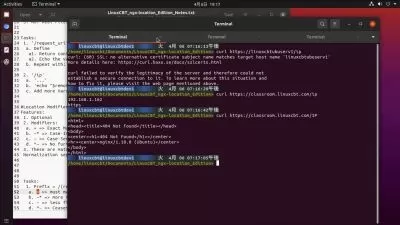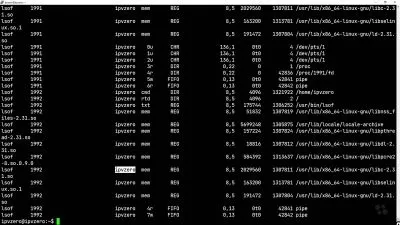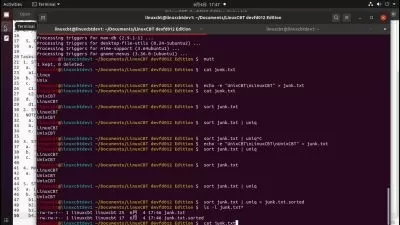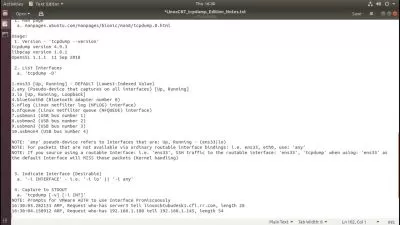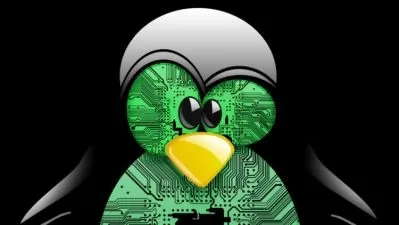Linux Administration & Linux Command Line For Beginners
The Linux Lighthouse
4:54:45
Description
Learn Linux Administration basics, Linux Command Line basics, Linux essentials, Linux History & Linux basic commands
What You'll Learn?
- After watching this course you will have a good understanding of the Linux operating system basics and fundamentals that will enable you to start your career.
- Install Linux CentOS 7
- The file system layout of Linux systems
- Creating, renaming, moving, and deleting files and directories.
- You will learn the most used Linux basic commands
- You will learn how to archive and compress files
- You will learn how to combine two or more commands using pipes
- You will learn how to redirect an output to a file
- Understand the essential Linux Commands
Who is this for?
What You Need to Know?
More details
DescriptionWelcome
Welcome to the (Linux Newbie Course: Linux Basics) course. This Linux Newbie Course covers Linux essentials. You will learn Linux Administration basics & Linux Command Line basics.
In this course, you will learn what is Linux, VirtualBox installation, Linux installation, Linux essentials, Linux file system hierarchy, Linux History & Linux basic commands.Â
Linux comes in a variety of distributions that are designed to meet the needs and technical expertise of their users. Linux Mint and other straightforward Linux distributions are excellent for home computers, while Ubuntu Linux is the best choice for developers, computer scientists & network administrators.
One misconception about Linux is that it is a far more sophisticated and technological alternative to well-known operating systems like Windows and MacOS. In actuality, Linux is an OS that is user-friendly, open-source, and adaptable and was created to address significant shortcomings in commercial operating systems.
Why Linux ?
Linux tends to be highly reliable and a more secure system than any other operating system (OS). Linux also is quite popular among many corporates and many consider it to be the lead operating system in the corporate world. Here are 5 reasons why you should start in Linux:
Linux Provides Good Career Opportunities
Much of the infrastructure that powers the internet, including routers and servers, is based on Linux
Linux is Used on Nearly Every Server
Linux is one such skill that allows an individual to experience a widespread growth in their profile after learning it
Linux is free and open source
Who this course is for:
- This Course is an introdiction for newbies who are not familiar with Linux
- This Linux introduction is not for Intermediate nor Advanced linux users
- Those interested in gaining the fundamental knowledge necessary to work with Linux using the shell's command line
Welcome
Welcome to the (Linux Newbie Course: Linux Basics) course. This Linux Newbie Course covers Linux essentials. You will learn Linux Administration basics & Linux Command Line basics.
In this course, you will learn what is Linux, VirtualBox installation, Linux installation, Linux essentials, Linux file system hierarchy, Linux History & Linux basic commands.Â
Linux comes in a variety of distributions that are designed to meet the needs and technical expertise of their users. Linux Mint and other straightforward Linux distributions are excellent for home computers, while Ubuntu Linux is the best choice for developers, computer scientists & network administrators.
One misconception about Linux is that it is a far more sophisticated and technological alternative to well-known operating systems like Windows and MacOS. In actuality, Linux is an OS that is user-friendly, open-source, and adaptable and was created to address significant shortcomings in commercial operating systems.
Why Linux ?
Linux tends to be highly reliable and a more secure system than any other operating system (OS). Linux also is quite popular among many corporates and many consider it to be the lead operating system in the corporate world. Here are 5 reasons why you should start in Linux:
Linux Provides Good Career Opportunities
Much of the infrastructure that powers the internet, including routers and servers, is based on Linux
Linux is Used on Nearly Every Server
Linux is one such skill that allows an individual to experience a widespread growth in their profile after learning it
Linux is free and open source
Who this course is for:
- This Course is an introdiction for newbies who are not familiar with Linux
- This Linux introduction is not for Intermediate nor Advanced linux users
- Those interested in gaining the fundamental knowledge necessary to work with Linux using the shell's command line
User Reviews
Rating
The Linux Lighthouse
Instructor's Courses
Udemy
View courses Udemy- language english
- Training sessions 35
- duration 4:54:45
- English subtitles has
- Release Date 2023/09/04






